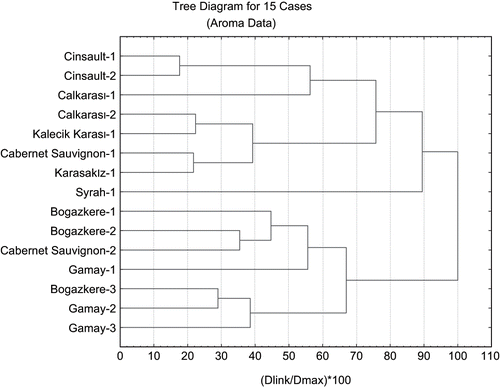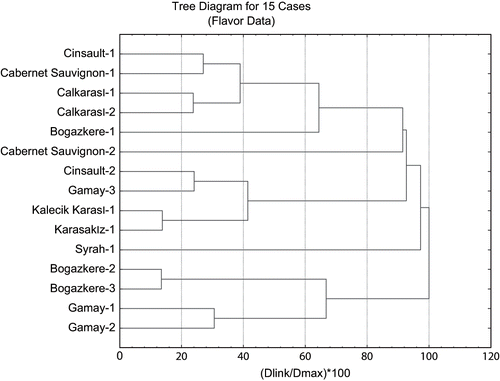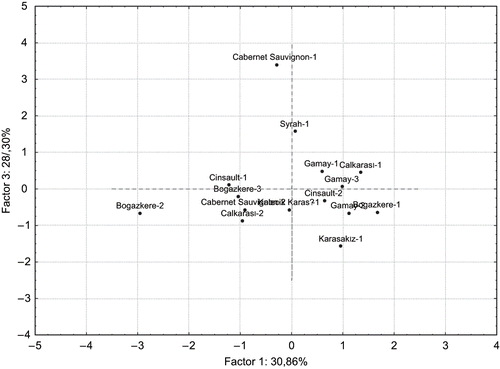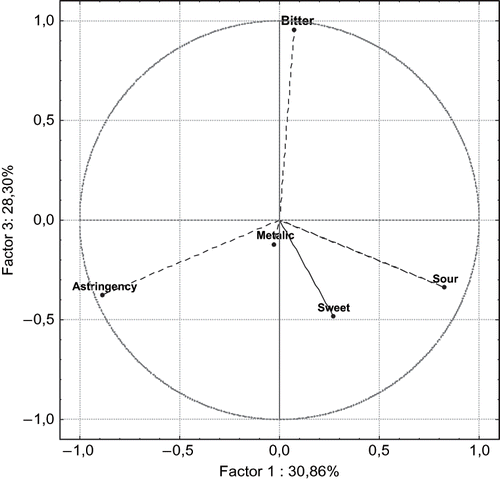Abstract
A total of 15 red wines produced from 8 grape varieties were evaluated and profiled by quantitative descriptive analysis. The results of wine aroma characteristics demonstrated the following major descriptors for each wine type: grape juice, flowery (Cinsaut), flowery, dust (Calkarası), raisin, wet wood (Boğazkere), raisin, caramel (Cabernet sauvignon), raisin, dust (Gamay), cornel cherry, pineapple (Syrah), caramel, grape juice (Kalecık karası), and medicinal, caramel (Karasakız). Flavor profile of red wines revealed specific flavor descriptors for each wine type, namely: sour cherry, medicinal, grape juice (Cinsaut), medicinal, hot wood, grape juice (Calkarası), raisin, cornel cherry, dry apricot (Boğazkere), raisin, medicinal, plum (Cabernet sauvignon), sour cherry, tobacco, raisin (Gamay), cornel cherry, grass, pineapple (Syrah), sour cherry, green, wood (Kalecik karası), and sour cherry, medicinal (Karasakız).
Keywords:
INTRODUCTION
Wine is a complex product containing volatile compounds, which contribute to its unique flavor. The flavor composition of wine is affected by the variety and ripeness of the grape, characteristics of soil, climatic conditions, grape growing, and winemaking techniques. These factors affect wine flavor independently and also by interacting with each other.[Citation1,Citation2] Flavor of wine is generally summarized in three main groups including the flavors originating from the grape, flavors produced during fermentation, and bouquet that results from the transformation of flavors during aging.[Citation3,Citation4]
Several studies have been conducted to classify wines according to origin by utilizing data regarding their volatile composition.[Citation5,Citation6,Citation7,Citation8,Citation9,Citation10,Citation11] Sensory descriptive analysis studies to cluster wines into groups of different geographic origin[Citation12,Citation13] were also studied. Multivariate statistical methods were used for the classification of the sensory properties of wines regarding varieties,[Citation14] or vintage.[Citation15,Citation16] Descriptive sensory studies[Citation17] and multivariate statistical methods were successfully used for evaluation of different foods, as well.[Citation18] In a recent study conducted by Carlucci and Monteleone,[Citation19] sensory characteristics of 16 young Anglianico wines from the 1998 vintage were analyzed by descriptive analysis. Results of the sensory data showed significant differences among the products for all the attributes except cherry aroma and pungent mouthfeel.
The aim of the present study was to determine the effect of using different grape varieties on sensory flavor characteristics of red wines. For this purpose, commercial wines from 4 international grape varieties cultivated in Turkey and from 4 native Turkish grape varieties were profiled by quantitative descriptive analysis. Calkarası, Boğazkere, Kalecik karası, and Karasakız grape varieties are native to Turkey, and there aren't any studies related to the flavor characteristics of these wines.
MATERIALS AND METHODS
Wine Samples
A total of 15, 2001 vintage red wines produced from 4 international grape varieties grown in Turkey (Cinsaut-2 samples, Cabernet Sauvignon-2 samples, Gamay-3 samples, Syrah-1 sample) and from 4 native Turkish grape varieties (Calkarası-2 samples, Boğazkere-3 samples, Kalecik karası-1 sample, Karasakız-1 sample) were studied. Wine samples were supplied from wineries and were stored in dark rooms at 12 ± 2°C prior to analysis.
Panel
The tests were conducted in an air conditioned sensory test laboratory equipped with individual booths. Panelists sensitivity to major tastes and odors were tested according to ISO-3972:1991.[Citation20] Wines (30 ml) were served at room temperature (20–23°C), in 170 mL-tulip-shaped glasses coded by using randomly selected 3-digit numbers, and evaluated by 5 trained judges. Repeatability of the judges were evaluated by giving the same wine sample 5 times and measuring the standard deviation of their results. Wine samples were tested under red light to mask the color differences that would effect flavor evaluations.
Wine samples were analyzed by quantitative descriptive analysis. Seven one-hour training sessions were conducted prior to the formal evaluation of wines. During the first 2 training sessions, descriptive terms for the taste, aroma, and flavor attributes that will be used in evaluation of wines were generated by sniffing to evaluate the aroma, then tasting and swallowing the samples for retronasal evaluation of flavors. In the following sessions, panel was provided with the reference standards, the judges identified and rated the intensity of each character on a 50 mm unstructured scale. The results from the evaluations were converted into numbers by measuring the distance in centimeters from the left end of the scale to the marked intensity. The series of descriptors and references used for describing red wine aroma and flavor are shown in . Fifteen formal sessions were held to evaluate the 15 wines in duplicate. Formal evaluation of wines was performed by consensus-based discussions.
Table 1 Aroma and flavor attributes of red wines and references
Data Analysis
The wines were evaluated and profiled by quantitative descriptive analysis. Analysis of variance was carried out on descriptive analysis data and least significant difference (LSD) test was used to determine the differences among the flavor attributes of wines (p < 0.05). The cluster analysis was performed as joining type (tree cluster) by using raw data of flavor, aroma, taste and astringency attributes. Furthest neighbor shape was selected as linkage and as a distance measure 1-Pearson-r. Missing data were case wise deleted. Scale plot was demonstrated as (dlink/dmax) × 100. Principal component analysis was run on the average set of data by using correlation matrix to examine attribute relationship and to show the differences in wines according to different grape varieties, tastes (sweet, sour, metallic, and bitter), and astringency character.
RESULTS AND DISCUSSION
Flavor profiles of wine samples including aroma, taste, and flavor characteristics were evaluated and mean values of aroma and flavor characteristics are given in and , respectively. Evaluating the scores of each wine type, the predominant descriptors for aroma were determined as: Cinsaut- grape juice, flowery; Calkarası- flowery, dust; Boğazkere- raisin, wet wood; Cabernet sauvignon-raisin, caramel; Gamay- raisin, dust; Syrah- cornel cherry, pineapple; Kalecik karası- caramel, grape juice and Karasakız-medicinal, caramel.
Table 2 Mean values of intensity for aroma attributes of red wines
Table 3 Mean values of intensity for flavor attributes of red wines
Regarding the tastes (sweet, sour, metallic, bitter) and astringency characters of each wine, the characteristic attributes were described as: Cinsaut- metallic, sweet; Calkarası- metallic, sour; Boğazkere- astringent, sour; Cabernet sauvignon- bitter, sweet; Gamay- metallic, sour; Syrah-bitter, metallic; Kalecik karası- astringent, sour and Karasakız- sweet, sour. Assessing the flavor attributes of different wines, dominant descriptors for each wine type were obtained as: Cinsaut- sour cherry, medicinal, grape juice; Calkarası- hot wood, grape juice; Boğazkere- raisin, cornel cherry, dry apricot; Cabernet sauvignon- medicinal, plum; Gamay- sour cherry, tobacco, raisin; Syrah- cornel cherry, grass, pineapple; Kalecik karası- sour cherry, green, wood; and, Karasakız- sour cherry and medicinal.
In a study conducted by Sivertsen et al.,[Citation21] sensory and chemical changes in Chilean Cabernet sauvignon wines during storage in bottles at different temperatures were evaluated by descriptive sensory analysis. Fruity, caramel, and bitter attributes were detected by the researchers in Cabernet sauvignon wines. In our study, the fruity character of the Cabernet sauvignon wine was identified as raisin and plum, and caramel was detected in the aroma of this wine. Abbott et al.[Citation22] associated higher intensities of nonberry sensory attributes such as stalky, earthy and tobacco with highest quality Australian Syrah wines, whereas black current aroma and flavor were found to be characteristic for Syrah wine in a study conducted by Reynolds et al.[Citation23] In our study, the major aroma and flavor descriptors of Syrah wine were detected to be cornel cherry and pineapple. These differences may be due to the different climatic conditions that were present during grape cultivation and also to the differences in production technology of wines.
Evaluating the aroma attributes, significant differences among wines were determined for yeast, tobacco, caramel, metallic, wet wood, raisin, medicinal, and grape juice characters. Tobacco, wet wood, and medicinal aroma attributes were determined to be specific for Gamay, Boğazkere, and Karasakız wines, respectively (p = 0.005). The yeast character was found to be significantly different between Gamay and Boğazkere (p = 0.045). The metallic character of Syrah wine was significantly different from Cinsaut, Boğazkere, and Gamay wines with p values of 0.029, 0.037, and 0.023, respectively. There were no significant differences between Kalecik karası and Karasakız wines in relation to caramel aroma. However, significant differences in caramel aroma were detected between these 2 wines and the other wine types such as: Cinsaut (p = 0.022), Boğazkere (p = 0.024), Gamay (p = 0.017), and Syrah (p = 0.038). Regarding the raisin character, there were no significant differences among Syrah, Kalecik karası and Karasakız wines. However, these 3 wines differ from Boğazkere wine (p = 0.020) and Cabernet sauvignon wine (p = 0.030). Significant differences were obtained between wines such as: Boğazkere-Cinsaut; Boğazkere-Calkarası (p = 0.0017); Cabernet sauvignon-Cinsaut-Calkarası (p = 0.012); Gamay-Cinsaut; Gamay-Calkarası (p = 0.033) wines related to the raisin character. Considering the grape juice aroma significant differences were obtained as: Cinsaut and all other wines (p < 0.004); Calkarası-Boğazkere (p = 0.028); Calkarası-Cabernet sauvignon (p = 0.040); Calkarası-Gamay (p = 0.028). Regarding caramel flavor, no significant difference was detected between Kalecik karası and Karasakız wines, but there were significant differences between Kalecik karası and Cabernet sauvignon (p = 0.004), Boğazkere (p = 0.003), Gamay (p = 0.004), and Syrah (p = 0.009).
Evaluating the flavor attributes, significant differences among wines were determined for sweet, tobacco, sour cherry, metallic, medicinal and sulphur characters. Sweet character for Karasakız (p < 0.005) and sulphur character for Calkarası (p < 0.005) were found to be significantly different from all other wine types. Tobacco and medicinal characters were demonstrated to be different between Gamay and Boğazkere (p = 0.035, p = 0.040) wines, respectively. Regarding the sour cherry attribute no significant differences were obtained between Kalecik karası and Karasakız although significant differences were recorded between these 2 wines and other wine types such as: Calkarası (p = 0.018), Boğazkere (p = 0.014), and Cabernet sauvignon (p = 0.018). The metallic character of Calkarası wines were obtained to be significantly different from Cinsaut (p = 0.017), Boğazkere (p = 0.002), Cabernet sauvignon (p = 0.004), Kalecik karası (p = 0.012), and Karasakız (p = 0.004). Significant differences for this character were also determined between Gamay-Boğazkere (p = 0.022), Gamay-Cabernet sauvignon (p = 0.034), and Gamay-Karasakız (p = 0.012).
The cluster diagram obtained with aroma data of different wine types demonstrated the relation between all examined wines. As it can be seen from , four main clusters are formed. The first cluster included Cinsaut 1 and Cinsaut 2 as having quite similar aroma properties. Calkarası 1 was also involved in the same group. The second cluster formed by four wines, demonstrated close relation between Calkarası 2-Kalecik karası and between Cabernet sauvignon 1-Karasakız. The third cluster involved Boğazkere 1, Boğazkere 2, and Cabernet sauvignon 2, from which the last two wines showed similar aroma properties. Boğazkere 3, Gamay 2 and Gamay 3 were involved in the fourth cluster. The aroma attributes of Syrah wine were accounted as significantly different from all mentioned groups. From the cluster diagram obtained by using the flavor data of different wine types, three main clusters could be recognized (). Cinsaut 1, Cabernet sauvignon 1, Calkarası 1, Calkarası 2, and Boğazkere 1 wines were involved in the first cluster. Cinsaut 2, Gamay 3, Kalecik karası, and Karasakız were involved in the second cluster. The third cluster involved Boğazkere 2, Boğazkere 3, Gamay 1, and Gamay 2.
The differences in wines according to different grape varieties, tastes (sweet, sour, metallic, and bitter) and astringency character were evaluated by principal component analysis. The total variance of extracted principal component analysis for 5 factors were found as: first factor 30.86%; second factor 29.67%; third factor: 28.30%; fourth factor 7.75%; and fifth factor 3.40%. Since the second and the third factors were determined to have similar percentages, the evaluations were conducted by using only the results of the last case (1–3). Thus, this clustering was nearest to the cluster diagram obtained with the raw data. From , it could be observed that all wines are located along the horizontal coordinate. Considering all samples, three main groups could be formed. The first group involved: Boğazkere 2–3, Cinsaut 1, Cabernet sauvignon 2, Kalecik karası, Calkarası 2 located on the left side of the coordinate. The second group involved Gamay 1–2–3, Calkarası 1, Cinsaut 2, Boğazkere 1 and Karasakız, located on the right side of the coordinate. The third group involved Cabernet sauvignon 1 and Syrah.
, shows the distribution of four main tastes and astringency character. As seen from the figure, each character is situated on the definite area, except the sweet and metallic descriptors. By plotting and , it was observed that bitter attribute is situated closer to the third wine group (Cabernet sauvignon 1 and Syrah); astringent attribute was closer to the first wine group (Boğazkere 2–3, Cinsaut 1, Cabernet sauvignon 2, Kalecik karası, Calkarası 2); sour, sweet and metallic attributes were closer to the second wine group (Gamay 1–2–3, Calkarası 1, Cinsaut 2, Boğazkere 1, and Karasakız). Besides this grouping, it can be seen from the figure that astringency attribute was characteristic for Boğazkere 2 wine, sweet attribute was characteristic for Karasakız, bitter attribute was characteristic for Cabernet sauvignon 1, and metallic attribute was characteristic for Kalecik karası.
CONCLUSION
This article showed that Turkish red wines are rich in aroma, taste, and flavor characteristics depending on the variety of the grapes used in production. Grape juice, flowery, dust, raisin, wet wood, caramel, cornel cherry, pineapple, and medicinal characters were determined as major aroma descriptors whereas, sour cherry, medicinal, grape juice, hot wood, raisin, cornel cherry, dry apricot, plum, tobacco, grass, pineapple, green, and wood characters were determined as flavor descriptors. Some of these characteristics seem to be specifically related to the grape variety. Further studies investigating the effect of different grape growing, harvesting, transporting, wine making, and aging techniques on the flavor of red wines produced from different cultivars in Turkey are recommended.
ACKNOWLEDGEMENTS
The authors wish to thank Ege University Science and Technology Centre for financial support, and to Sevilen, Doluca, Yazgan, Melen, and Pamukkale wineries for supplying the wine samples.
REFERENCES
- Arozarena , I. , Casp , A. , Remedios , M. and Navarro , M. 2000 . Multivariate Differentiation of Spanish Red Wines According to Region and Variety . Journal of the Science of Food and Agriculture , 80 : 1909 – 1917 .
- Thorngate , J.H. 1997 . The Physiology of Human Sensory Response to Wine: A Review . American Journal of Enology and Viticulture , 48 : 271 – 279 .
- Rapp , A. 1988 . “ Wine Aroma Substances from Gas Chromatographic Analysis ” . In Wine Analysis , Edited by: Linskens , H.F. and Jackson , J.F. 29 – 66 . Berlin : Springer .
- Ribereau-Gayon , P. 1978 . “ Wine Flavor ” . In Chemistry and Technology , Edited by: Charalambous , G. and Inglett , G.E. 355 – 380 . New York : Academic Press .
- Maarse , H. , Slump , P. , Tas , A.C. and Schefer , J. 1987 . Classification of Wines According to Type and Region Based on Their Composition . Zeitschrift für Lebensmittel- Untersuchung und Forschung , 184 : 198 – 203 .
- Moret , I. , Scarponi , G. and Cescon , P. 1994 . Chemometric Characterization and Classification of Five Venetian White Wines . Journal of Agricultural and Food Chemistry , 42 : 1143 – 1153 .
- Noble , A.C. , Williams , A.A. and Langron , S.P. 1984 . Descriptive Analysis and Quality Ratings of 1976 Wines from Four Bordeaux Communes . Journal of the Science of Food and Agriculture , 35 : 88 – 98 .
- Rapp , A. and Güntert , M. 1985 . Beitrag zur Chrakterisierung des Weines der Rebsorte WeiBer Riesling: II. Untersuchung der Aromastoffzusammensetzung deutscher WeBweine der Rebsorten WeiBer Riesling, Müller-Thurgau und Silvaner . Vitis , 24 : 139 – 150 .
- Rapp , A. , Suckrau , I. and Versini , G. 1993 . Untersuchungen des Trauben-und Weinaromas: Beitrag zur Sortenchrakterisierung neutraler Rebsorten (Silvaner, WeiBburgunder, Rulander) . Zeitschrift für Lebensmittel – Untersuchung und- Forschung , 197 : 249 – 254 .
- Rapp , A. , Volkmann , C. and Niebergall , H. 1993 . Untersuchungen flüchtiger Inhaltsstoffe des Weinaromas: Beitrag zur Sortenchrakterisierung von Riesling und Neuzüchtungen mit Riesling-Abstammung . Vitis , 32 : 171 – 178 .
- Schreier , P. , Drawert , F. , Junker , A. and Reiner , L. 1976 . Application of Multiple Discriminant Analysis for the Differentiation of Grape Varieties Using Volatile Wine Constituents. Mitteilungen Höhere Bundeslehr- und Versuchsanstalt für Wein- und Obstbau . Klosterneuburg , 26 : 225 – 234 .
- Guinard , J. and Cliff , M. 1987 . Descriptive Analysis of Pinot Noir Wines from Carneros, Napa and Sonoma . American Journal of Enology and Viticulture , 38 : 211 – 215 .
- Heymann , H. and Noble , A.C. 1989 . Comparison of Canonical Variate and Principal Component Analyses of Wine Descriptive Analysis Data . Journal of Food Science , 54 : 1355 – 1359 .
- Noble , A.C. 1988 . “ Analysis of Wine Sensory Properties in Modern Methods of Plant Analysis ” . In Wine Analysis , Edited by: Linskens , H.F. and Jackson , J.F. 10 – 28 . Berlin : Springer .
- Noble , A.C. and Shannon , M. 1987 . Profiling Zinfandel Wines by Sensory and Chemical Analysis . American Journal of Enology and Viticulture , 38 : 1 – 5 .
- Ohkubo , T. , Noble , A.C. and Ough , C.S. 1987 . Evaluation of Californian Chardonay Wines by Using Sensory and Chemical Analyses . Sciences des Aliments , 7 : 269 – 274 .
- Kala , A. and Prakash , J. 2004 . Nutrient Composition and Sensory Profile of Differently Cooked Green Leafy Vegetables . International Journal of Food Properites , 7 : 659 – 669 .
- Nakai , S. , Amantea , G. , Nakai , H. , Ogava , M. and Kanagawa , S. 2002 . Definition of Outliers Using Unsupervised Principal Component Similarity Analysis for Sensory Evaluation of Foods . International Journal of Food Properites , 5 : 289 – 306 .
- Carlucci , A. and Monteleone , E. 2001 . Statistical Validation of Sensory Data: A Study on Wine . Journal of the Science of Food and Agriculture , 81 : 751 – 758 .
- ISO . 1991 . 3972: Sensory Analysis-Methodology-Method of Investigating Sensitivity of Taste , 7 Geneva : ISO .
- Sivertsen , H.K. , Figenschou , E. , Nicolaysen , F. and Risvik , E. 2001 . Sensory and Chemical Changes in Chilean Cabernet Sauvignon Wines during Storage in Bottles at Different Temperatures . Journal of the Science of Food and Agriculture , 1 : 1561 – 1572 .
- Abbott , N.A. , Coombe , B.G. and Williams , P.J. 1991 . The Contribution of Hydrolyzed Flavor Precursors to Quality Differences in Shiraz Juices and Wines . American Journal of Enology and Viticulture , 42 : 167 – 174 .
- Reynolds , A.G. , Wardle , D.A. and Dever , M. 1996 . Vine Performance, Fruit Composition and Wine Sensory Attributes of Gewürzraminer in Response to Vineyard Location and Canopy Manipulation . American Journal of Enology and Viticulture , 47 : 77 – 92 .



